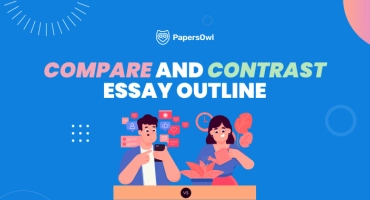What Is Analogy and How to Use It in Your Essay
Table of contents
Analogy is a literary technique that compares related or unrelated concepts, events, or notions to one another. Before writing an analogy, you should know that this concept can implement other literary devices like metaphors or allegories.
This article sets the stage for exploring the diverse landscape of analogical writing.
As you progress, you will also:
- Define examples of analogies and discover how they elevate your essay-writing skills.
- You will learn how analogy enhances essay writing and why it can help you improve your style.
- Examine and master the use of metaphor and simile.
- Master an eight-step professional research paper writing service guide to learn how to craft effective analogies quickly.
Before we proceed with practical examples and dive deep into theory, let’s start with the analogy definition.
Definition of Analogy in Writing
An analogy in essay writing represents a description that compares this to that by simplifying a certain idea. What you compare may have or may not have similarities. The use of comparative language is common for an analogy. One may encounter phrases like “experienced like an old dog” or “writing essays as a busy working bee.” An analogy general idea can be made between what a young child can do and what modern computers can generate. You can compare and persuade. Likewise, a persuasive essay author can provide an analogy between a youngster and artificial intelligence.
Analogy’s purpose is to draw comparisons and a more detailed image with a clearer description. When an unknown concept is represented, literal analogies bring more clarity. When you are asked to create a connection between unrelated concepts, analogies become helpful. When you encounter metaphors, similes, or allegories, it indicates their practical use.
Types of Analogies
Speaking of types of analogies in writing, one should focus on various types of relations.
- Analogies that identify identical relationships. These analogy examples are most common as they talk about related concepts. It is like Los Angeles to the United States or guitar to piano. By learning how to write an analogy, one can see the relation between the same country or the musical instrument analogy.
- Analogies that identify shared abstraction. An analogy of figurative language stands for shared abstractions comparing something unrelated. It aims to find commonalities or patterns that make sense. Such cases can compare learning a foreign language to watering seeds that grow into flowers as time passes. Since it is the journey, not the destination, it helps to understand the abstractive language.
- A relation of a certain part to something whole analogy. It is a comparison of two sets of the same object or two parts of the same concept.
- Cause-and-effect relation analogy. It speaks of causes like the lack of water, which causes dehydration.
- Source to product. Think about the wood and the piano manufacturing common analogies.
- Object and a clear purpose. This one can talk about books and reading or water and swimming.
- Comparison of typical characteristics. If something is essential for an object, it becomes the source of the analogy between them.
- Coming from something general to specific parts. You can make an analogy by offering a good detective book by comparing two or more things.
- Metaphors and Allegories. These elements of an analogy in poetry add creativity and literary power, like being tired as a dog or feeling hungry like a wolf.
Tip: Using literal analogies can enhance your writing by building a strong connection between concepts. For example, when you need to provide a literature analysis essay assignment, you use the creativity and imagination of the author by seeking analogies, among other things.
How Does Analogy Compare and Enhance Writing?
The most important element of using analogy examples in your essay is its enhancement. From clarity to a better description, it offers a mental bridge to the readers. If something in an essay is obscure or complex, an analogy makes it easier to understand demanding concepts.
- Creating Vivid Mental Images.
An analogy compares things and shows a way to help people understand things. When we compare raising children to building a house brick after brick, we receive an instant mental image. Similarly, adding creative writing to an essay helps to enhance the emotional state of things.
- Simplifying Complex Concepts.
Analogy examples help to simplify things that are overly complicated and demanding. It can be used in engineering or healthcare when a certain action is compared to what people know in practice. Likewise, comparing chemical aspects of work to cooking or culinary and human taste can help to simplify things. It is a practical example that gives people more accessible things they can easily connect with.
- Using Analogy to Influence and Convince.
An analogy compares marketing and business writing concepts when the main purpose is to motivate customers. The same is true when the author has to convince. Think about social or environmental causes where cause-and-effect rhetorical devices can become a turning point for readers. A good comparison with a logical argument can help inspire and simplify things, even in marketing. Due to their explanatory nature, analogies are common in argumentative writing essays or school debates.
- Rhetorical Devices and Analogy.
Most analogies represent rhetorical devices, as we should use at least one type of comparison. Still, it does not work the same way as similes or metaphors that deal with resemblance aspects. A correct example will seek parallels between things that are not obvious or connected in one way or another. When used for an essay assignment, it will add rhetoric to help readers determine what common qualities can be established based on what is not apparent at first glance.
- Analogy in Different Genres.
When you are asked to use examples of analogies for a school essay, the trick is to determine the main purpose and use it correctly. It means that using an analogy in a detective story is not the same as using it for marketing purposes. The same applies when an author must classify different objects for analogy in literature. Likewise, a problem-and-solution analogy can be used in education or to deliver a similar concept. If we choose history books, we can provide old and modern analogies that help us understand historical concepts more clearly.
Metaphor and Simile: Cornerstones of Analogy (What This Greek Word Means?)
Metaphors and similes represent the main cornerstones of the use of an analogy. Take a quick look at several academic essays related to social or literary subjects, and you will most definitely encounter at least one case. Writers use metaphors to compare something or use them for a specific effect. The tricky part is that a simile is a special sub-category of a metaphor, which shows that most similes are parts of metaphors, yet not the other way around. Let’s identify each case!
- Metaphors.
A metaphor (from the Greek word “to transfer”) represents a figure of speech that aims to compare things to achieve a specific rhetorical effect. A good example would be saying that the world is a stage or that people in love represent an endless ocean of love. Of course, metaphors are not meant to be taken literally!
- Similes.
A typical simile will create a different type of comparison by implementing the words “like” and “as” in writing. The most famous example of a simile in writing would be the phrase “Life is a beach.” One can spot it by using a direct comparison. It must be used with caution or have an additional explanation. Remember that examples of an analogy should show and explain things, which is why a simile or a metaphor can be used.
- Identifying the Main Differences.
Summing up regarding distinctions for writing analogies, we receive the following five rules:
- A simile aims to show that something is like some other object.
- A metaphor literary device uses poetical writing to say something is another thing.
- The purpose of analogy is to offer an additional explanatory point, not merely show.
- Metaphors and similes can work for an enhancement effect when using an analogy in essay writing.
- A simile is a special subgenre of metaphors, yet not all metaphors are similes.
Crafting Effective Analogies Eight Steps Guide
Making an analogy efficient and fitting always comes down to the practical clarity of a certain description. Depending on the genre, start by analyzing your target audience to make things more accessible. If there’s a concept, think about the main elements and see what is most relevant.
- Analyze the Target Concept. Start with a proper analysis of the main concept that you outline in your essay. If you are dealing with medical practices, do not create analogies that do not fit. Keep within high morals and be sensitive. If you are composing a reflective essay, some types of analogy can be related to your past or certain experiences from your life. These should help people understand you in a better way.
- Choosing the Concept for Explanation. When you seek diverse types of analogies, think about a concept that can be used for explanatory purposes. It means that you may use historical books or comparisons to certain movies or events that have taken place before. For example, you may consider comparing a business deal to Boston’s Tea Ceremony or woodworking to learning how to play guitar well.
- Highlight Relevant Similarities. Although analogies in literature are always about seeking similarities, not all will remain clear to your readers. Therefore, one should focus on relevant similarities and highlight them the best way you can. If you state that our world is like a theater where all of us are merely actors, it should not come out of the blue but have an explanation as you quote William Shakespeare’s words.
- Forming the Basis of the Analogy. Before you add it to your essay, think about making an introduction. An analogy never comes on its own because it requires a special paragraph that highlights it and leads to an emotional climax. Once you have got what is an example of an analogy, add more analytical writing or an explanatory sentence to help your readers see your point more clearly.
- Illustrating the Analogy with Real-World Situations. An analogy sentence that does not make sense will not work. The trick is to help people connect and see how your example can be used in practice. When you say that working at Tesla corporation was like surviving Arizona’s heatwave, most Americans will be able to relate to that.
- Adapting the Analogy to Audience Knowledge. When your analogy is overly complex and relates to engineering or law essay writing, you may not achieve success with that. Remember to adapt your comparison to the level of your target audience. The key is to make things accessible and ensure that you are understood.
- Ensuring Natural Fit and Relevance. It is best to use your analogy in the middle of a paragraph. This way, you can add a special introduction and make it fit naturally. It should fit within a relevant paragraph, making it apparent to avoid using analogies as the final sentence. More space is essential since you must add transition words in an essay.
- Weaving Analogies into the Narrative. Use an analogy to show and explain a certain concept or idea. Use the same narrative tone if your essay is written this way. Adjust your writing accordingly if you use an explanatory or argumentative tone.
Polishing Your Writing Style With Analogy Examples
Coming up with a good analogy may seem challenging, especially when you must get the essay done at the last minute or when you are unsure about the emotional power of your writing. Using an analogy in writing helps you improve things and add clarity, even to the most complex subjects. Refer to the eight-step writing guide above before you start, and don’t forget to double-check existing analogy types! Lastly, remember the importance of balancing active and passive voice as you explain and use various literary devices to enhance your writing further.






